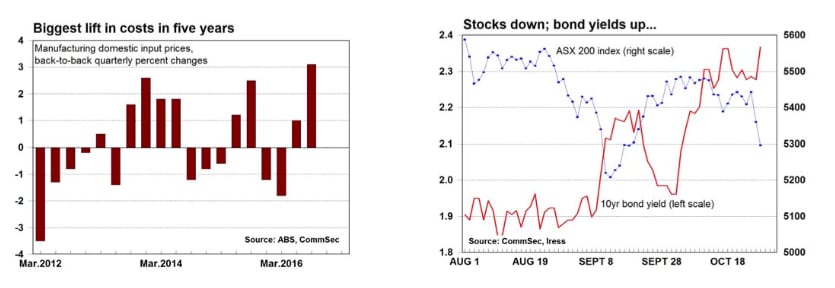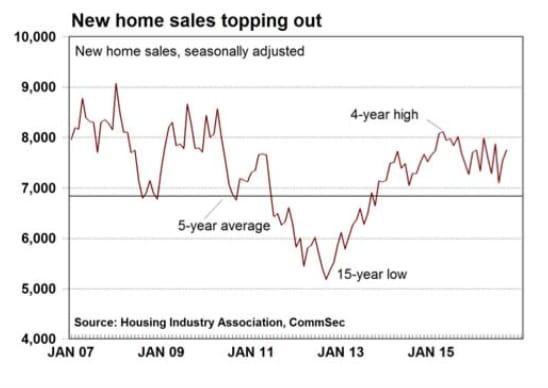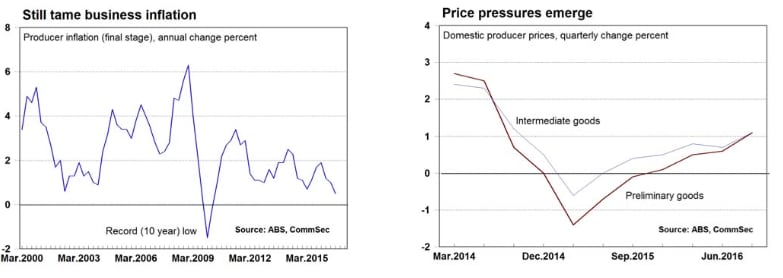4 percent chance of Cup Day rate cut: CommSec's Craig James
GUEST OBSERVER
Inflation appears to be making a comeback. That certainly seems the conclusion on global bond markets with Australian 10-year bond yields hitting 2.38 percent – the highest yield in almost six months. The higher bond yields are serving to draw investors away from equities markets, causing the ASX 200 index to fall for the third day.
There was some justification for the inflation fears in the latest data on producer prices. Manufacturing input costs rose 2.0 percent in the September quarter with domestic costs up 2.2 percent.
On top of the 0.9 percent lift in the June quarter, manufacturing input costs are experiencing the biggest gains in five years. The question is how much and how quickly prices flow through to final producer and consumer prices.

The saving grace in the September quarter was the fact that the Aussie dollar rose, driving prices of imported goods lower. But if the US economy continues to lift, driving interest rates higher, the Aussie dollar may have a few headwinds to contend with over the next two months.
What do the figures show?
Producer prices
The Producer Price Index (PPI), or final stage prices, rose by 0.3 percent in the September quarter to stand 0.5 percent higher than a year ago. Of final stage prices, domestic good prices rose by 0.5 percent while import good prices fell by 1.2 percent in the quarter.
The Bureau of Statistics notes that the 0.3 percent lift in final stage prices was “mainly due to rises in the prices received for other agriculture which includes bananas, beans and tomatoes (+8.3 percent), sheep, beef cattle and grain farming; and dairy cattle farming (+11.9 percent) and electricity supply, gas supply and water supply, sewerage and drainage services (+1.7 percent).
The lift in prices was “partly offset by falls in the prices received for petroleum refining and petroleum fuel manufacturing (-5.5 percent), computer and electronic equipment manufacturing (-1.9 percent) and cigarette and tobacco product manufacturing (-5.0 percent).”
Prices of intermediate goods rose by 0.6 percent in the quarter to stand 0.2 percent higher over the year. Preliminary stage materials rose by 0.6 percent in the quarter to be up 0.1 percent over the year.
Manufacturing input prices rose by 2.0 percent in the September quarter while output prices rose 0.9 percent. Domestic input costs rose by 2.2 percent in the September quarter.
ABS notes rises in prices paid by manufactures to the Agriculture (+5.1 percent), Metal ore mining (+5.3 percent) and Oil and gas extraction (+4.4 percent) industries drove the rise in the price index of Input to the Manufacturing industries. Products contributing to these rises were cattle & calves, silver ores and crude oil.
Rises in prices received by manufactures for outputs of Meat processing (+6.5 percent), Basic non-ferrous metal manufacturing (+4.6 percent), Sugar manufacturing (+16.0 percent), Copper, silver, lead and zinc smelting (+6.4 percent) and Industrial gas manufacturing (+6.8 percent) industries drove the rises in the price index of Output of the Manufacturing industries. Products contributing to these rises were beef and veal, precious metal recovery, sugar and non-refinery LNG.

New home sales
Total seasonally-adjusted new home sales (houses and apartments) rose by 2.7 percent in September after a 6.1 percent rise in August. Detached house sales rose by 3.8 percent in September after a 2.9 percent rise in August.
Private sector seasonally adjusted multi-unit sales eased by 0.8 percent in September 2016 after rising by some 17.8 percent in August.
The Housing Industry Association reported: “In the month of September 2016, detached house sales fell in four out of the five states covered by the report, an exact reversal of the situation in August. During September 2016, the largest fall in sales was recorded in South Australia (-23.0 per cent), followed by Western Australia (-17.2 per cent), New South Wales (-12.9 per cent) and Queensland (-2.6 per cent). Victoria was the only state to record an increase in new home sales over this period with 14.0 per cent growth in sales over the past year.
What is the importance of the economic data?
The producer price figures are important in flagging price pressures at an early stage. If business costs are rising, the risk is that these will be passed on in terms of higher prices of final consumer goods. The Consumer Price Index is regarded as the key gauge of economy-wide inflation.
The Housing Industry Association releases data on the sales of new homes each month. The HIA collects the data each month from a sample of Australia's largest 100 home builders. The survey covers around 14 percent of the home building industry.

What are the implications for interest rates and investors?
Is inflation making a comeback? There are some early signs, especially in agriculture and metal, but it is early days. While cost pressures are emerging, the $64 question is whether businesses will pass through the high costs to consumers.
Chances of a rate cut next Tuesday stand at just 4 percent. And those market views have been reinforced by recent data showing a big lift in the terms of trade and higher domestic manufacturing costs.
The Australian sharemarket is exposed to higher bond yields because a high proportion of investor returns are provided by dividends as opposed to increases in share prices. As a result yield-hungry investors may seek to trim some exposures in the sharemarket, especially utilities and banks, to chase higher yields in fixed asset markets. The historic price-earnings ratio has been holding above long-term averages, suggesting that the market has been relatively dear rather than cheap. The historic PE was 16.65 in September, above the 15.0-15.5 long- term average.
Craig James is the chief economist at CommSec.
Jonathan Chancellor
Jonathan Chancellor is one of Australia's most respected property journalists, having been at the top of the game since the early 1980s. Jonathan co-founded the property industry website Property Observer and has written for national and international publications.
Tags:
Interest Rates
